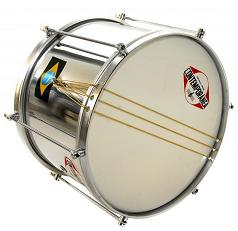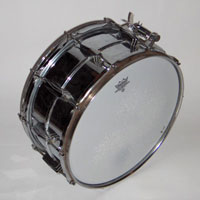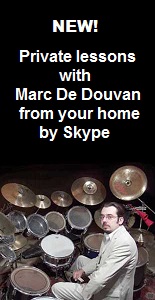
: : : Percussions : : Brazil : Instruments
The caixa


The Brazilian caixa (or "caixa de guerra " (left photo above: Contemporanea 12" caixa)) differs from the European snare drum because it is often with smaller diameter (10 or 12"), deeper, and with aluminum shell with tension rods going from one hoop to the other (such as "surdos", "repiniques" or european old "tarole" (the snare drum with double tension is a recent American invention in late nineteenth century)). There can be also fewer strands for the snare and transparent plastic hitting skin (not coated). These features give a more clear, dry, high pitched and precise tone. But nothing prevents the "sambist ("sambista": samba player) to use American (right photo above: Ludwig supraphonic snare drum) or European type snare drum (cultural mix "obliges"!).
There are also specifically Brazilian techniques like the roll with one hand (see "Repenique") or " mixed stick", the right hand, stronger, playing the basic rhythm, and the left a filling of rest beats, "pianissimo" (as the "tamborim"). Personally, I prefer the technique of classic European military drum (accents and rolls (with single and double strokes) with both hands), more difficult, because it requires a perfect ambidexterity, but more powerful and with better endurance (used in some samba schools but not all).
In samba, the snare drum plays traditionally a Biguine punctuated at the end of measure by a roll, or the basic tamborim pattern. You can also just play the basic ganza pattern, which the snare of the resonance skin allows to imitate perfectly (rhythm more for beginners). In "samba-reggae", the caixa plays the "bossa- nova ", the Cuban "clave", the Jamaican "syncopation" or a phrase very syncopated inspired by "cuica". The "marcha" ("march"), another typical rhythm, is halfway between the European military drumming and the African biguine.
In the solo, caixa can express all its potential for improvisation, which is mostly rhythmic (but like the pandeiro player caixa usually keeps a steady flow and continuous piano notes ("ghost notes"), from which emerge accents and "syncopated" rolls ("jumped ruffed")). Finally, in more intimate context (jazz, pagode, etc.), jazz brushes or "cross stick" are often used, as the "jazz-samba" drummers do.
Audio demos played by Marc De Douvan (2005):
1: Samba biguine (with accents, single and double stroke rolls)
2: Rhythm of tamborim with "mixed sticking"
3: Bossa nova by accents (samba school Mocidade Independente de Padre Miguel)
4: Clave by accents (samba-reggae school Olodum from Bahia)
5: Reggae guitar syncopation with "jumped single stroke roll" (Olodum)
7: Samba Marcha ("marchinha").
Marc De Douvan, October 2005, translation in English: May 2013.
© 2005 Marc de Douvan Crédits Mentions légales
